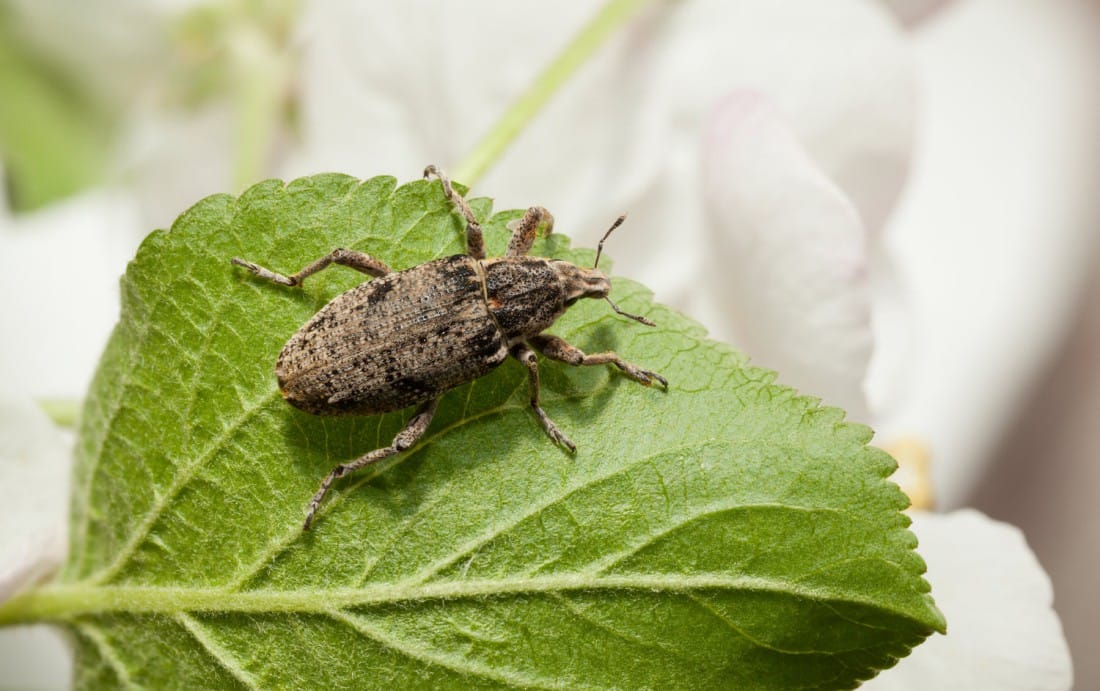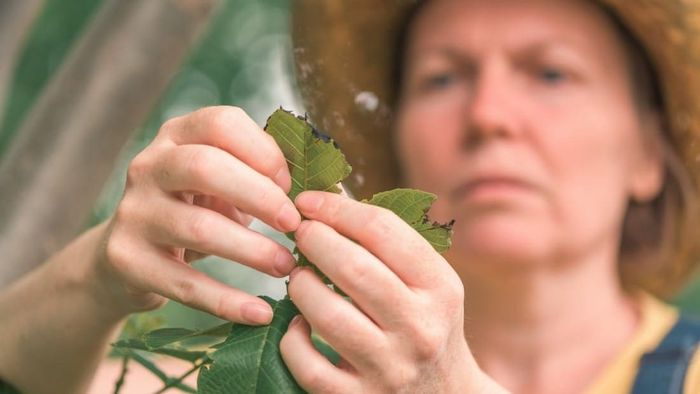GARDEN PEST: Weevils are often hard to spot lurking under foliage (Image: Getty)
This article contains affiliate links, we will receive a commission on any sales we generate from it. [Learn more]
Most gardens have their fair share of unwelcome visitors that damage plants, such as slugs, snails and greenflies. But there’s another pest you may be less familiar with – the weevil. These sneaky critters can wreak just as much havoc and are often very difficult to spot.
However, knowing what they look like and where they’re likely to be will help you to spot problems early on. Gardening expert Calum Maddock at HomeHow has shared everything you need to know about weevils, plus environmentally friendly ways to control them.
These small beetles often have a mottled or metallic shell and what looks like a long snout. They sometimes have long, angled antennae. While weevils are common in most habitats, some like to feed on a specific type of tree, crop or plant, but others aren’t so fussy.
MORE ON PESTS
Weevils are usually most active at night, making them harder to spot until the damage is done. When they feed on buds and shoots, the growth and development of plants can be stunted, and damage to leaves, stems and roots can severely weaken a plant, potentially killing off young plants and saplings.
Identify your weevils
There are more than 500 different weevil species living in the UK and they differ in appearance. These are the nine types you’re most likely to find lurking under the foliage in your garden:
1. Vine weevils
This is the type of weevil you’re most likely to come across in your garden, and has the biggest reputation for being a pest. It’s known as a ‘broad-nosed weevil’ because it has a large snout (or rostrum) and their antennae are quite prominent.
Vine weevils have dull black bodies that are almost a centimetre in length, and if you look closely at their shell, they appear dimpled. They aren’t particularly fussy eaters and will go for shrubs, fruit and flowering plants – including primulas, fuchsias and strawberries – in borders, raised beds and containers.
2. Privet weevils
This close cousin of the vine weevil is is rather partial to privet hedges but will also go for lilac bushes. The privet weevil is less problematic as the damage it causes is mostly cosmetic. While they also have the distinctive snout, they are a lighter, brown colour and slightly smaller in size than vine weevils.
3. Figwort weevils
These weevils are very particular about their food, so you’re only likely to find them on plants in the figwort family, which includes buddleias. Figwort weevils are only around 5mm in length and are lighter in colour than vine weevils. They have the distinctive long snout, but their antennae are much smaller. Their bodies are mottled with a white patch on the head and can appear slightly furry. They’re easiest to spot on leaves and buds in the spring.
4. Green immigrant leaf weevil
Most people think of weevils as having dull brown-black bodies, which means the green immigrant leaf weevil can be easily overlooked as a pest. It has a vibrant green body with an iridescent shine and striped patterning, but the broad snout gives it away as a weevil. It tends to hang out in woodland areas but can be found in gardens with apple, pear and cherry trees.
 BAD REPUTATION: The vine weevil beetle is the most common type found in gardens (Image: Anest/Getty)
BAD REPUTATION: The vine weevil beetle is the most common type found in gardens (Image: Anest/Getty)
5. Nettle weevil
The nettle weevil is also colourful and similar in appearance with a metallic shell and broad snout, but has a more blue-green colouring. They are common across England and Wales and will eat fruit trees, ornamental hedges and roses, as well as nettles.
6. Pea and bean weevil
Pea and bean weevils are only around 5mm in length and their grey-brown mottled body makes them hard to spot on the ground. But if you notice lots of little notches on the leaves of your peas and beans, they’re likely to be present somewhere.
7. Strawberry blossom weevil
This weevil is another picky eater, so you’re only likely to encounter it if you’re growing strawberries and raspberries in your garden. They look very similar to vine weevils but are only around half the size with a long, thin snout.
8. Clay-coloured weevil
This mottled brown weevil is just under a centimetre in length with a broad snout and long antennae, like many other weevils. It mostly feeds on raspberry and rhododendron bushes and is commonly found near agricultural land, where it is considered a significant pest.
9. Large pine weevil
This is another weevil that’s mainly found in forests, as it tends to feed on conifers, including commercial spruce and pine trees. However, they’re particularly fond of young trees, so can be found in gardens in countryside gardens. The large pine weevil is a little bigger than other species, with a distinctive snout and patches of yellow or light brown hairs on its shell.

When there aren’t too many of them, weevils play a vital role in making gardens wildlife-friendly, as they’re food for birds and toads. However, large numbers can do noticeable harm. You can use an insecticide on weevils, however, there are plenty of ways to control them without using chemicals.
How to control weevilsBirds: Common garden birds, including robins, blackbirds and blue tits, will eat weevils. Making your garden more attractive to birds, by building bird boxes and supplying them with water, will help keep these pests under control.Frogs and toads: It’s not just birds that eat weevils, frogs and toads do too. Consider adding a pond and plenty of vegetation to create a welcoming habitat for amphibians.Biological controls: Nematodes are microscopic organisms that kill the larvae of garden pests, including weevils. This is a quick solution and can be effective within weeks, if you follow the package instructions carefully.Sticky barriers: If you have plants and shrubs in containers, you can stop weevils from attacking them by spacing the pots out and placing sticky barriers around the sides and rims. This will help to capture the adults before they can lay eggs. There are special sticky tapes and gels you can use for this.Manual removal: The final method is a bit more labour-intensive but is equally effective – picking the weevils off your plants by hand. The best way to do this is to pinpoint the garden areas where leaves are being eaten and head out at night to catch the weevils in the act.
Eco-friendly solutions
This article contains affiliate links and we may receive a commission on any sales we generate from it. Learn more.
Nematode powder: A pack of Nemasys Natural Vine Weevil Killer costs £12.99 on Amazon. Mix with water and apply to soil. Kills grubs before they attack plants
Nematode trap: The NemaTop Adult Vine Weevil Trap costs £19.99 at Gardening Naturally. Nematodes are imbedded in a gel in the wooden board’s grooves.
Concentrate: The 480ml bottle of BugClear Ultra Vine Weevil Killer concentrate is down to £12.98 on Amazon. Kills weevils and larvae.
Sticky bands: A 5m roll of Glue Bands for Fruit Trees costs £9.99 at Gardening Naturally. Protects against adult vine weevils and other pests.
Prices correct at the time of publication.
MORE ON DETTERING PESTS


Comments are closed.